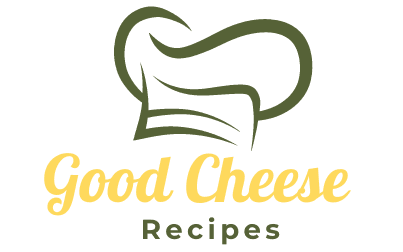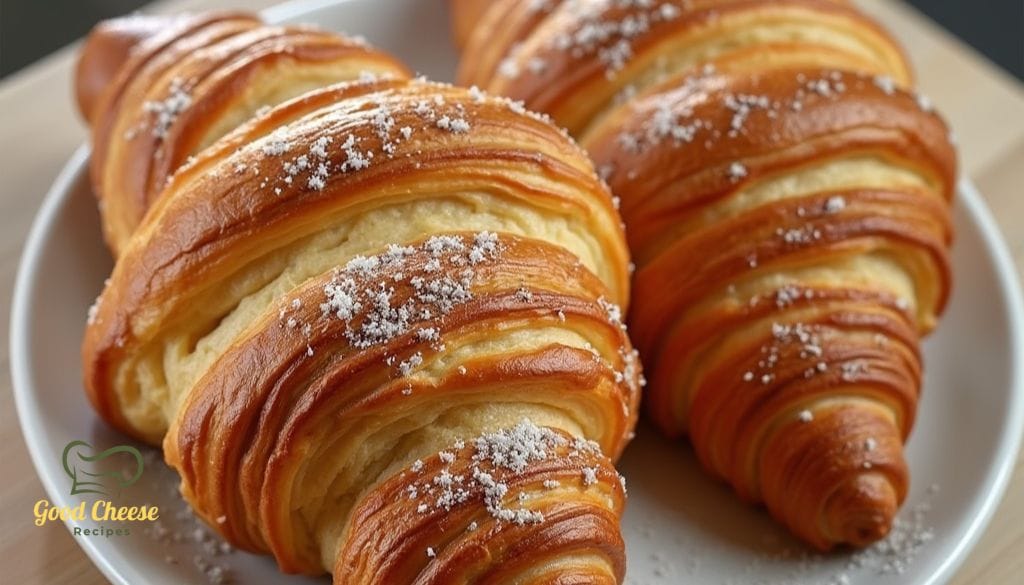Introduction
Gipfeli, often referred to as the Swiss croissant, is a beloved breakfast pastry known for its light, flaky layers and buttery taste. Unlike the classic French croissant, Gipfeli has a slightly denser texture and can be made with less butter, giving it a unique Swiss twist.
Why You Should Try This Gipfeli Recipe
If you love homemade pastries, this Gipfeli recipe is perfect for you! It’s easy to make, requires simple ingredients, and fills your kitchen with a delicious, buttery aroma. Plus, nothing beats the taste of freshly baked Swiss croissants straight from the oven.
The Popularity of Gipfeli in Switzerland
Gipfeli is a staple in Swiss bakeries, often enjoyed with coffee or hot chocolate. It’s commonly eaten for breakfast or as a light snack. Whether plain, chocolate-filled, or almond-stuffed, Gipfeli is a treat that brings a taste of Switzerland into your home.
In this blog post, you’ll learn how to make authentic Swiss Gipfeli from scratch, including step-by-step instructions, expert tips, and serving ideas to enjoy your homemade croissants like a true Swiss! 😊🥐
Table of Contents
What is Gipfeli? (Swiss Croissants Explained)
What is Gipfeli? (Swiss Croissants Explained)
Origin of Swiss Gipfeli and Its Difference from French Croissants
Gipfeli has deep roots in Swiss baking traditions and is believed to have been influenced by Austrian and French pastries. While both Gipfeli and French croissants share a similar crescent shape and buttery, flaky texture, there are some key differences between them:
- Butter Content – French croissants are made with a high butter-to-flour ratio, resulting in a more delicate, airy texture, while Gipfeli often contains less butter, making it slightly denser.
- Dough Type – Gipfeli can be made with yeast-based or puff pastry dough, whereas croissants strictly use laminated dough with multiple butter layers.
- Flavor Profile – Swiss Gipfeli sometimes has a mildly sweet or slightly savory taste, whereas French croissants are purely buttery and neutral.
- Texture & Appearance – Gipfeli tends to be less flaky and has a smoother, golden brown crust, while croissants have distinct, crisp, and delicate layers.
Despite these differences, both pastries are loved worldwide and serve as a delicious treat for breakfast or snacks!
Why Gipfeli is a Popular Swiss Breakfast Pastry
Gipfeli is a staple in Swiss bakeries and homes, often enjoyed with coffee, tea, or hot chocolate. Here’s why it remains a favorite Swiss breakfast option:
- Convenience & Portability – Perfect for an on-the-go breakfast, Gipfeli is widely available in Swiss cafés, bakeries, and supermarkets.
- Versatility – It pairs well with sweet and savory spreads, such as butter, jam, honey, or cheese.
- Cultural Tradition – Gipfeli is an essential part of Swiss breakfast culture, often served alongside Bircher muesli, cheese, and fresh fruit.
- Homemade Enjoyment – Many Swiss families love baking their own Gipfeli on weekends, filling their homes with the warm aroma of fresh pastries.
Common Variations of Gipfeli (Plain, Chocolate, Almond-Filled)
While the classic plain Gipfeli remains a favorite, there are several delicious variations to try:
- Plain Gipfeli – The traditional version made with buttery yeast dough, ideal for enjoying with jam or butter.
- Chocolate Gipfeli (Schoggigipfeli) – A sweet variation filled with rich Swiss chocolate, making it perfect for dessert or a special breakfast treat.
- Almond-Filled Gipfeli (Mandelgipfeli) – Stuffed with a sweet almond paste filling, often topped with sliced almonds and powdered sugar.
- Whole Wheat Gipfeli – A healthier alternative, made with whole wheat flour for a slightly denser, nuttier flavor.
- Savory Cheese Gipfeli – A unique twist filled with Swiss cheese, making it a great snack or light meal.
No matter which version you choose, Gipfeli is a must-try pastry that brings a taste of Switzerland into your home!
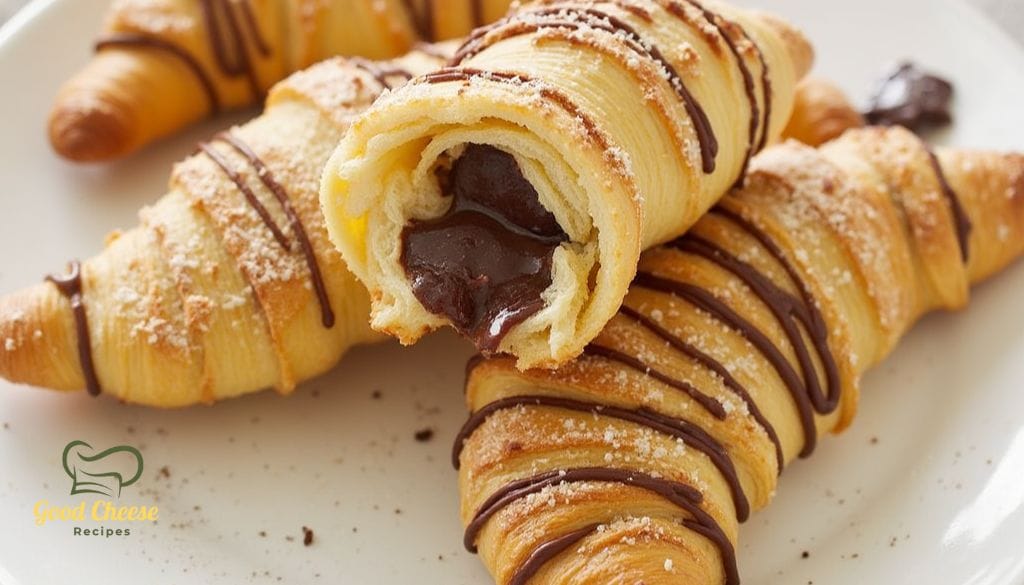
Essential Ingredients for Making Gipfeli
The Secret to Perfect Gipfeli – Ingredients and Techniques
Flour, Yeast, Butter, and Milk – The Key to Soft, Flaky Layers
The secret to a perfectly baked Swiss Gipfeli lies in its simple yet high-quality ingredients. Each component plays a crucial role in achieving the right texture, flavor, and consistency:
- Flour – A high-protein bread flour works best for Gipfeli, as it helps develop strong gluten strands, giving the dough its elasticity and ability to trap air for a light, fluffy texture.
- Yeast – Gipfeli typically uses active dry yeast or fresh yeast, which helps the dough rise and develop a slightly chewy, airy structure.
- Butter – One of the most important ingredients, butter gives Gipfeli its rich flavor and delicate layers. Using cold, high-fat butter (like European-style butter) ensures proper lamination.
- Milk – Adding warm milk to the dough results in a softer crumb and slightly richer taste compared to water-based doughs. Some recipes also incorporate a touch of cream for extra softness.
By using high-quality ingredients, you can ensure that your homemade Gipfeli turns out just as delicious as those found in Swiss bakeries!
Importance of Lamination and Butter Layers
Lamination is the key technique that gives Gipfeli its characteristic flaky, airy texture. This process involves folding butter into the dough multiple times, creating thin alternating layers of butter and dough. When baked, the butter melts and releases steam, causing the layers to separate and expand.
Here’s why proper lamination is crucial:
- Creates Light, Flaky Layers – The more precise your folds, the more airy and delicate your Gipfeli will be.
- Prevents Butter from Leaking – Keeping the butter cold during the folding process helps maintain distinct layers instead of melting into the dough.
- Enhances Flavor & Texture – The layers of butter and dough caramelize in the oven, giving Gipfeli its buttery richness and crispy golden crust.
🔹 Pro Tip: Work quickly and chill the dough between folds to prevent the butter from softening too much!
Choosing the Right Egg Wash for a Golden Finish
The final step in achieving bakery-style Gipfeli is brushing the dough with an egg wash before baking. This helps create a shiny, golden-brown crust that makes the pastries look and taste irresistible.
There are a few different types of egg wash you can use:
- Whole Egg + Milk – The most common egg wash, this mixture gives Gipfeli a rich, golden sheen with a slightly softer crust.
- Egg Yolk + Cream – Creates a deep golden-brown color and a glossy finish, ideal for a professional bakery look.
- Egg White + Water – Produces a lighter, crisper crust with a subtle shine, great for a more delicate pastry.
🔹 Pro Tip: Lightly brush the Gipfeli with egg wash using a soft pastry brush and avoid applying too much, as excess liquid can cause uneven browning.
By paying attention to ingredients, lamination, and finishing techniques, you’ll master the art of making authentic Swiss Gipfeli at home! 🥐✨

Step-by-Step Guide to Making Gipfeli at Home
Mastering the Art of Making Gipfeli – Step-by-Step Guide
Preparing the Dough and Letting It Rise
The foundation of a perfect Swiss Gipfeli starts with properly preparing the dough. This step is crucial in developing structure, texture, and flavor.
- Activate the Yeast:
- In a bowl, mix warm milk (about 100°F or 37°C) with a teaspoon of sugar and active dry yeast. Let it sit for 5–10 minutes until it becomes foamy. This ensures the yeast is alive and will help the dough rise properly.
- Mix the Dough:
- In a large mixing bowl, combine bread flour, a pinch of salt, sugar, and softened butter.
- Gradually add the yeast mixture, stirring continuously.
- Knead the dough for about 10–12 minutes until it becomes smooth, elastic, and slightly tacky.
- First Rise (Fermentation):
- Place the dough in a greased bowl, cover it with a damp cloth, and let it rise at room temperature for 1–2 hours or until it doubles in size.
- This fermentation process enhances the flavor and makes the dough more pliable for the next steps.
🔹 Pro Tip: If you’re short on time, place the dough in a warm, draft-free spot (like an oven with the light on) to speed up rising.
Rolling and Folding Techniques for Perfect Layers
To achieve the distinct flaky layers of Gipfeli, you’ll need to use lamination techniques, similar to those used in croissant-making. This involves incorporating cold butter into the dough through a series of folds and rolls.
- Prepare the Butter Block:
- Roll out cold butter into a thin rectangle between two sheets of parchment paper.
- Place it in the fridge while you roll out the dough.
- Rolling Out the Dough:
- Lightly flour your work surface and roll out the dough into a large rectangle, about twice the size of your butter block.
- Encasing the Butter:
- Place the butter block in the center of the dough and fold the edges over to completely enclose it.
- Roll the dough out into a thin rectangle again.
- Folding for Layers:
- Use the book fold or letter fold technique (folding the dough into thirds or quarters).
- Chill the dough for 30 minutes, then repeat the rolling and folding process 2–3 more times to create multiple layers.
🔹 Pro Tip: Work quickly and keep the dough cold at all times to prevent the butter from melting into the dough.
Shaping, Proofing, and Baking Gipfeli for the Best Texture
- Shaping the Gipfeli:
- Roll out the laminated dough into a large rectangle (about 1/4 inch thick).
- Cut triangles (about 8–10 cm wide at the base).
- Starting from the wide base, roll each triangle tightly toward the tip, slightly stretching the dough as you roll to create the classic crescent shape.
- Final Proofing:
- Arrange the shaped Gipfeli on a baking sheet lined with parchment paper, leaving space between them.
- Cover with a light towel and let them proof for 1–2 hours until they become puffy and slightly jiggly when touched.
- Proofing is essential for a light and airy texture inside.
- Applying the Egg Wash:
- Just before baking, brush each Gipfeli with a thin layer of egg wash (beaten egg + milk or cream) for a golden, shiny crust.
- Baking:
- Preheat the oven to 375°F (190°C).
- Bake for 18–22 minutes, or until the Gipfeli is golden brown and crispy on the outside.
- Cooling and Serving:
- Let them cool slightly on a wire rack before serving.
- Enjoy your homemade Swiss Gipfeli with butter, jam, honey, or a cup of coffee! ☕🥐
🔹 Pro Tip: If you want extra flaky layers, let the shaped Gipfeli rest in the fridge for 30 minutes before baking to ensure the butter remains solid, which enhances flakiness.
Tips for the Perfect Swiss Gipfeli
Perfecting Gipfeli: Baking, Storing, and Creative Variations
Getting the Right Oven Temperature for Flaky Results
Baking Gipfeli at the right temperature is crucial to achieving that perfect balance of a crispy, golden exterior and a soft, airy interior.
- Preheat the Oven Properly:
- Always preheat your oven to 375°F (190°C) for at least 15–20 minutes before baking. A consistent temperature ensures even baking and proper puffing.
- Using a baking stone or steel can help maintain an even temperature.
- Oven Rack Positioning:
- Bake Gipfeli on the middle rack to avoid burning the bottoms while allowing the tops to brown beautifully.
- Steam for Extra Flakiness:
- To create extra crispy, bakery-style layers, place a small pan of hot water at the bottom of the oven. The steam helps the butter layers expand and creates an ultra-light texture.
- Baking Time & Signs of Readiness:
- Bake for 18–22 minutes, or until they turn a deep golden brown.
- If needed, rotate the tray halfway through baking for even coloring.
- Tap the bottom of a Gipfeli—if it sounds hollow, it’s perfectly baked!
🔹 Pro Tip: Avoid opening the oven door frequently, as this can cause temperature fluctuations and affect the rise of the pastry.
How to Store and Reheat Gipfeli for Freshness
Gipfeli taste best fresh out of the oven, but if you have leftovers, proper storage and reheating can help maintain their texture and flavor.
- Storing at Room Temperature (Short-Term):
- Let the Gipfeli cool completely.
- Store them in an airtight container or wrapped in parchment paper to prevent them from drying out.
- They stay fresh for up to 2 days.
- Freezing for Long-Term Storage:
- Once cooled, place the Gipfeli in a ziplock bag or an airtight container, separating layers with parchment paper.
- Freeze for up to 3 months.
- Reheating for Freshness:
- Oven Method (Best for Flakiness):
- Preheat oven to 350°F (175°C) and warm for 5–7 minutes.
- Air Fryer Method:
- Reheat at 325°F (160°C) for 3–4 minutes.
- Microwave (Not Recommended for Crispiness):
- Heat in 10-second intervals for a warm but softer texture.
- Oven Method (Best for Flakiness):
🔹 Pro Tip: If reheating frozen Gipfeli, let them thaw at room temperature for about 30 minutes before baking at 350°F (175°C) for 7–8 minutes.
Adding Variations – Chocolate, Cheese, or Nut-Filled Gipfeli
While classic plain Gipfeli are delicious on their own, you can experiment with different fillings for variety and indulgence.
- Chocolate-Filled Gipfeli: 🍫
- Before rolling the dough into a crescent shape, place a small piece of dark or milk chocolate on the wide base.
- Roll tightly and bake as usual.
- Drizzle with melted chocolate or dust with powdered sugar for extra sweetness.
- Cheese Gipfeli: 🧀
- Spread a thin layer of grated Swiss cheese (Gruyère, Emmental, or cheddar) on the dough before rolling.
- Brush the top with egg wash and sprinkle extra cheese for a crispy, golden crust.
- A pinch of herbs like thyme or rosemary adds extra flavor.
- Nut-Filled Gipfeli (Almond or Hazelnut): 🌰
- Mix ground almonds, sugar, a splash of milk, and a hint of cinnamon for a delicious nutty filling.
- Spread the mixture on the dough, roll it up, and bake.
- For a bakery-style touch, finish with a light dusting of powdered sugar or sliced almonds.
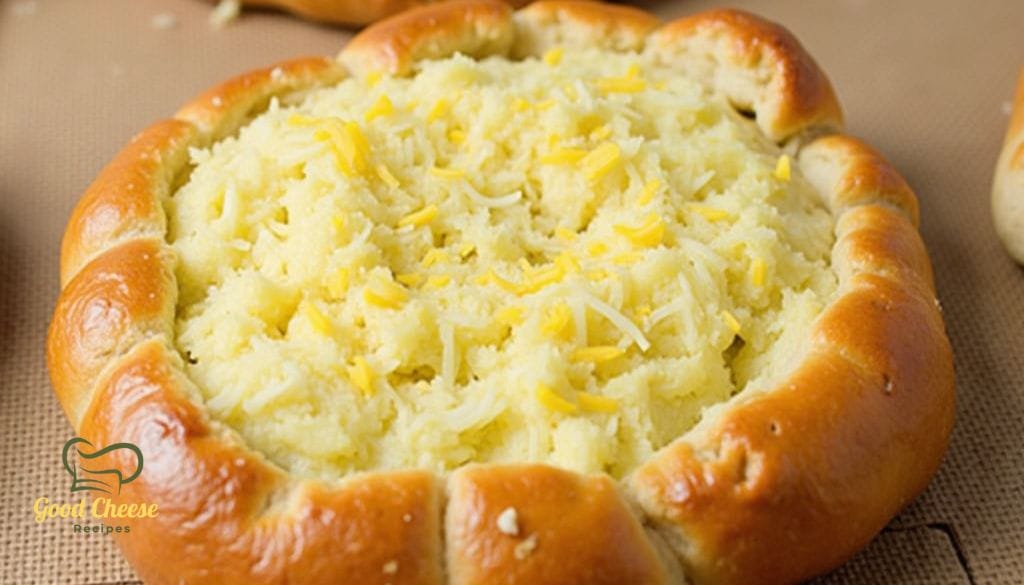
🔹 Pro Tip: For a luxurious twist, try filling Gipfeli with pistachio cream, hazelnut spread, or even a touch of honey and walnuts.
Serving and Enjoying Gipfeli Like a Swiss
Enjoying Gipfeli: Serving, Pairing, and Finding Authentic Inspiration
Best Ways to Serve Gipfeli – With Jam, Honey, or Butter
Gipfeli are best enjoyed fresh and warm, but what you serve them with can elevate the experience!
- Classic Butter Spread 🧈
- A simple high-quality butter spread on a warm Gipfeli enhances its flaky texture and rich flavor.
- Try Swiss-style butter for an authentic touch.
- Sweet Additions 🍯🍓
- Jam & Fruit Preserves: Spread apricot, raspberry, or strawberry jam for a fruity contrast.
- Honey Drizzle: A touch of local Swiss honey adds a delightful sweetness.
- Nutella or Almond Butter: Perfect for a more indulgent treat!
- Savory Options 🧀
- Pair with a slice of Swiss cheese (Gruyère or Emmental) for a balance of creamy and flaky textures.
- Serve with herbed cream cheese for a rich, tangy bite.
🔹 Pro Tip: Warm your Gipfeli slightly before adding toppings to enhance flavors and textures!
Pairing Gipfeli with Coffee or Swiss Hot Chocolate
A delicious Gipfeli deserves the perfect drink pairing to complete your breakfast or snack experience.
- Swiss Hot Chocolate 🍫☕
- A rich, creamy Swiss hot chocolate made with melted dark chocolate, whole milk, and a touch of cream pairs beautifully with a buttery Gipfeli.
- Top with whipped cream or shaved chocolate for extra indulgence.
- Coffee & Espresso ☕
- A fresh café crème (Swiss-style coffee with steamed milk) complements the buttery, flaky layers.
- A strong espresso or cappuccino balances the richness with its bold, roasted flavors.
- Tea Pairings 🍵
- A mild black tea or chamomile works well for those who prefer tea over coffee.
- Chai latte with warm spices is also a great match!
🔹 Pro Tip: Dip your Gipfeli lightly into coffee or hot chocolate for a classic European breakfast experience.
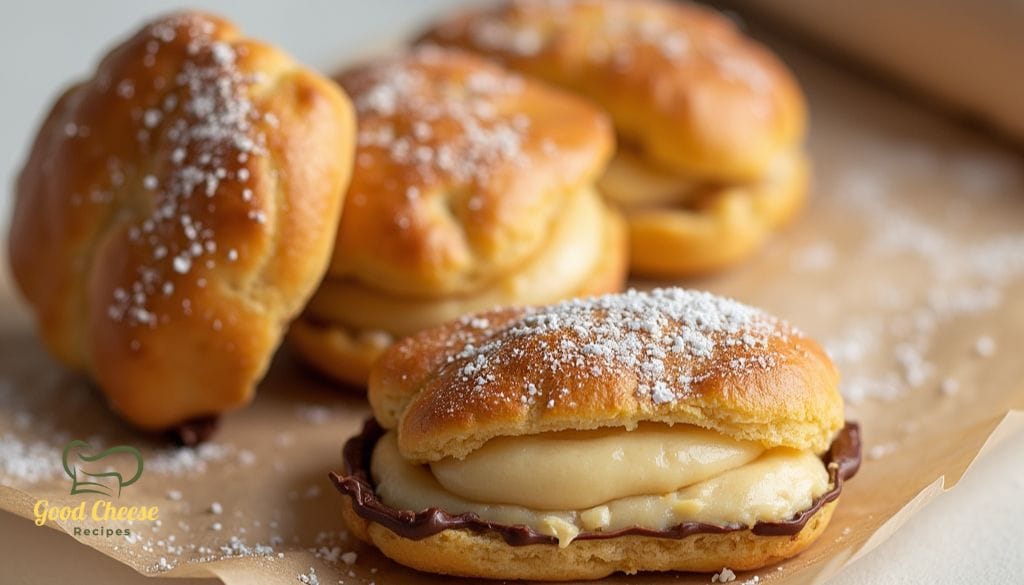
Exploring Swiss Bakeries for Authentic Inspiration
If you want to experience the best authentic Swiss Gipfeli, visiting a local Swiss bakery (Bäckerei) is a must!
- Famous Swiss Bakeries to Visit 🇨🇭
- Confiserie Sprüngli (Zürich): A legendary Swiss bakery known for traditional pastries and exquisite chocolates.
- Bäckerei-Konditorei Hug (Luzern): A family-run bakery famous for its artisanal bread and delicious Gipfeli.
- Zehnder Bäckerei (Bern): Offers some of the best buttery and crisp Gipfeli in Switzerland.
- What to Look for in a Great Gipfeli
- Golden, crispy exterior with a flaky, delicate crust.
- Soft, airy inside with visible layers.
- The rich buttery aroma melts in your mouth.
- Trying Different Regional Variations
- Butter Gipfeli: The classic, most common version.
- Nuss-Gipfeli: A nut-filled variation, often with a touch of cinnamon.
- Schoggi-Gipfeli: Filled with Swiss chocolate for a sweet treat.
🔹 Pro Tip: When in Switzerland, visit a bakery early in the morning to enjoy freshly baked Gipfeli at their best!
Gipfeli is a versatile and delicious Swiss pastry that can be enjoyed in many ways. Whether you prefer it plain, with sweet spreads, or paired with coffee, there’s always a way to savor this iconic treat. Would you go for a classic butter Gipfeli or try a chocolate-filled version first? Let me know! 😊🥐
